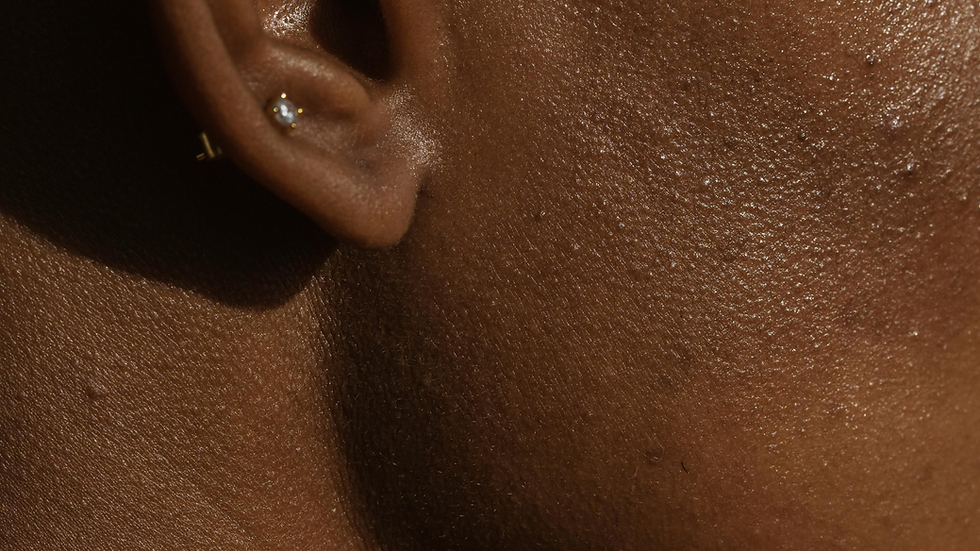How to Identify Skin Types
- Minene
- Dec 12, 2022
- 2 min read

In order to take care of your skin, it is essential to know what your skin needs. And to understand what your skin needs, you need to know what your skin type is. Choosing products that are not suitable for your skin type can be uncomfortable. We’re here today to help you identify your skin type.
The method to determining your skin type is “Watching and Waiting” according to Cerave. This process involves cleansing your face with a gentle cleanser (non-exfoliating), waiting for approximately 30 minutes without applying anything to your skin, and watching how your skin reacts.
Results
If your skin is oily, shiny, or greasy all over, chances are you have oily skin.
If your skin feels tight or flakey after, you might have dry skin.
If you don’t experience both conditions above, you might have either normal skin or combination skin.
The difference between normal and combination (or you might call it combo or combi in short) is that normal skin types usually have balanced oil on your skin whereas combination skin type usually is oilier on the T-zone and dry in some areas like for instance, the cheeks.
Skin Types and Their Common Characteristics
Oily Skin
Prone to acne
Large pores
Greasy throughout the day
Dry Skin
Tight
Flakey
Prone to fine lines
Dull complexion
Normal Skin
Normal-sized pores
Radiant-looking skin
Combination Skin
Prone to blackheads and whiteheads
Enlarged pores
Oily T-zone
Dry in some areas
After knowing your skin type, it is much easier to choose products accordingly. However, you should also keep in mind that weather, environment, diet, and hormones can also change your skin types; therefore, you should also switch up your products to cater to your skin as well.
Disclaimer: The information in this article is not intended as medical advice, and is for entertainment purposes only.
សម្រួលជាភាសាខ្មែរខាងក្រោម៖
ដើម្បីថែរក្សាស្បែកយើងឲ្យមានសុខភាពល្អ យើងត្រូវដឹងថាស្បែកយើងត្រូវការអ្វី។ ហើយដើម្បីដឹងថាស្បែកយើងត្រូវការអ្វី យើងត្រូវដឹងថាស្បែកយើងប្រភេទអី ដោយសារតែភាគច្រើនបញ្ហាស្បែកមានទំនាក់ទំនងជាមួយប្រភេទស្បែក។ ខ្ញុំជឿថាការប្រើផលិតផលដែលមិនសាកសមនឹងប្រភេទស្បែកយើងអាចមានអារម្មណ៍ថាមិនសូវស្រួល។ ដូច្នេះហើយថ្ងៃនេះសង្ឃឹមថាពួកយើងអាចជួយអ្នកក្នុងការស្គាល់ប្រភេទស្បែករបស់អ្នក។
វិធីដែលយើងអាចស្គាល់ពីប្រភេទស្បែកខ្លួនឯងនោះគឺតាមវិធីមួយដែលCeraveបានលើកឡើង គឺការលាងមុខជាមួយសាប៊ូលាងមុខស្រាល (មិនជម្រុះកោសិកា) រួចរង់ចាំរយះពេល៣០នាទីឬកន្លះម៉ោង រួចសង្កេតមើលស្បែករបស់អ្នកបន្ទាប់ពី៣០នាទីនោះ។
លទ្ធផល
បើសិនជាស្បែកអ្នករាងឡើងខ្លាញ់ រអិល ចែងចាំងពេញមុខនោះអ្នកប្រហែលជាមានស្បែកខ្លាញ់ហើយ។
បើសិនជាស្បែកអ្នកមានអារម្មណ៍តឹង របក នោះអ្នកមានស្បែកស្ងួត។
បើសិនជាអ្នកមិនខ្លាញ់ពេញមុខ ហើយក៏មិនតឹងរបក អ្នកប្រហែលជាមានស្បែកប្រភេទធម្មតាឬស្បែកចម្រុះ។
លក្ខណៈខុសគ្នានៃប្រភេទស្បែកទាំងពីរនេះគឺត្រង់ថា ស្បែកធម្មតាមានកម្រិតខ្លាញ់ឬប្រេងលើស្បែកល្មមមិនច្រើនពេក។ តែចំណែកឯស្បែកចម្រុះវិញ គឺមានខ្លាញ់ច្រើននៅតំបន់t-zoneដែលជាតំបន់នៅលើថ្ងាស ច្រមុះ និងចង្កា ហើយកន្លែងខ្លះទៀតអាចស្ងួតវិញដូចជាលើថ្ពាល់ជាដើម។
លក្ខណៈទូទៅនៃប្រភេទស្បែកនីមួយៗ
ស្បែកខ្លាញ់
· ងាយឡើងមុន
· ខ្លាញ់រលោងចែងចាំង
· រន្ធញើសធំ
ស្បែកស្ងួត
· តឹង
· របក
· ស្នាមជ្រីវជ្រួញ
· ស្រអាប់
ស្បែកធម្មតា
· រន្ធញើសធម្មតា
· ស្បែកភ្លឺថ្លា
ស្បែកចម្រុះ
· ងាយឡើងមុនក្បាលខ្មៅ
· រន្ធញើសធំ
· ខ្លាញ់តំបន់ច្រមុះ ថ្ងាស ចង្កា
· ស្ងួតតាមតំបន់
នៅពេលដែលយើងស្គាល់ប្រភេទស្បែករួចហើយ យើងអាចជ្រើសរកផលិតផលទៅតាមនឹងបាន។ យើងក៏ត្រូវចាំផងដែរថាប្រភេទស្បែកយើងអាចផ្លាស់ប្ដូរតាមកត្តាមួយចំនួនដូចជារដូវកាល បរិវេណជុំវិញ របបអាហារ និងអរម៉ូនផងដែរ។ ដូច្នេះហើយយើងក៏គួរផ្លាស់ប្ដូរផលិតផលទៅតាមស្បែករបស់យើងដែរ។
សម្គាល់៖ ព័ត៌មានទាំងឡាយនៅក្នុងអត្ថបទនេះមិនត្រូវបានរាប់ជាលក្ខណៈវេជ្ជសាស្ត្រឡើយ។





Comments